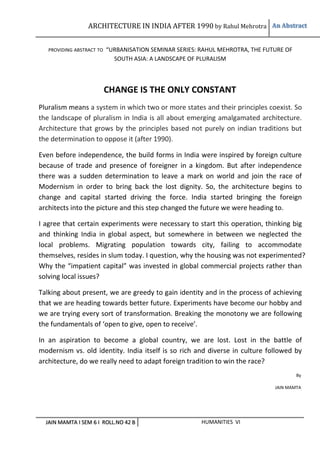ARCHITECTURE IN INDIA AFTER 1990 by Rahul Mehrotra : abstract
- 1. ARCHITECTURE IN INDIA AFTER 1990 by Rahul Mehrotra HUMANITIES VI PROVIDING ABSTRACT TO ŌĆ£URBANISATION SEMINAR SERIES: RAHUL MEHROTRA, THE FUTURE OF SOUTH ASIA: A LANDSCAPE OF PLURALISM CHANGE IS THE ONLY CONSTANT Pluralism means a system in which two or more states and their principles coexist. So the landscape of pluralism in India is all about emerging amalgamated architecture. Architecture that grows by the principles based not purely on indian traditions but the determination to oppose it (after 1990). Even before independence, the build forms in India were inspired by foreign culture because of trade and presence of foreigner in a kingdom. But after independence there was a sudden determination to leave a mark on world and join the race of Modernism in order to bring back the lost dignity. So, the architecture begins to change and capital started driving the force. India started bringing the foreign architects into the picture and this step changed the future we were heading to. I agree that certain experiments were necessary to start this operation, thinking big and thinking India in global aspect, but somewhere in between we neglected the local problems. Migrating population towards city, failing to accommodate themselves, resides in slum today. I question, why the housing was not experimented? Why the ŌĆ£impatient capitalŌĆØ was invested in global commercial projects rather than solving local issues? Talking about present, we are greedy to gain identity and in the process of achieving that we are heading towards better future. Experiments have become our hobby and we are trying every sort of transformation. Breaking the monotony we are following the fundamentals of ŌĆśopen to give, open to receiveŌĆÖ. In an aspiration to become a global country, we are lost. Lost in the battle of modernism vs. old identity. India itself is so rich and diverse in culture followed by architecture, do we really need to adapt foreign tradition to win the race? By JAIN MAMTA
